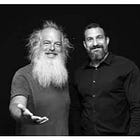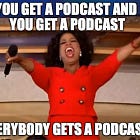🎙 Do you miss podcasting? Part Two
Or, my failed attempt at Essentialism-inspired focus
Catch up on part one here first:
When I decided to (attempt) “going pro” on podcasting by (hopefully) transforming it into a full-time gig, I knew it would be a numbers game.
I also knew, deep down, that those numbers had as likely a chance at tipping in my favor as a winning lottery ticket—but hey—at least there was ostensibly some skill involved in this roll of the career dice.
For me, going pro on podcasting meant no longer trying to mOnEtiZe an OnLInE funNel of DIgiTal coUrsEs and coaching, etc. to justify the resources required. At this point in my career, I wanted greater focus. I no longer wanted to spread my energy and attention across the systems required for juggling over ten streams of income. I was diversified but diluted, and wanted to double down on the few I loved most.
What would be possible if I could harness all my best attention into a single area? Greg McKeown made the case for this in his 2014 book, Essentialism: The Disciplined Pursuit of Less, with a single diagram:
I couldn’t unsee this image. It persisted in my mind for years. Perhaps my lack of podcast traction was due to distraction. Even though making the shows self-sustaining was a long shot, I also knew I would regret not giving myself the chance.
This would require achieving two things I had not proven to be very good at in my first six years of podcasting:
Growing the show to achieve enough downloads, so that
Those downloads yielded a CPM (cost per thousand) that made it worth monetizing the shows via host-read ads.
Allow me to struggle through some math:
If I had 1,000 listeners per episode (which I did for Free Time, about 3K for Pivot), I would be paid ~$25 for one ad + alllllll the rigamarole of working with that advertiser, setting up contracts and invoices, recording the draft, processing their feedback, recording revisions, chasing down those invoices, etc.
A typical 45-minute episode might include four to eight ads; more than that is pushing the limit; the ads risk becoming a tiresome distraction turning away listeners. Two pre-roll ads (less valuable, easy to fast-forward), two mid-roll insertion moments (most valuable), and two post-roll (the least valuable).
6 ads x $25 CPM = $150. Nowhere near worth the time involved in managing those six advertisers. This is why agencies require at least 10,000 downloads per episode; at least then, you’re making closer to $1,500 per episode x 4 = $6,000 per month (of which they’ll take a 15-20% cut).
After two years of trying to bust into the coveted inner circle of full-time podcasters, I finally mustered the courage to ask for an introduction to an ad agency. I was elated when longtime blog friend and author whose values I so admire, Cal Newport graciously offered to make a personal introduction to his agency.
“We love Cal!” they replied instantly, directly suggesting we schedule a call. I was floating! This could really happen! If they could sell (aligned) ads on my behalf, I could focus on the part I was uniquely skilled at, interviewing guests. The revenue stream would help offset production and marketing costs, and eventually—hopefully—a living, achieving escape velocity and taking the whole enterprise to the next level.
Before I share the results of that call, allow me a mini-detour.
The first thing I do when arriving at the gym is visit the lifeguard at the pool. They look at their clipboard to report open slots for the solo swim lane, allocated in 30-minute blocks. At the appointed time, the narrow lane at the far edge of the pool is all mine—and mine alone.
Swimming makes me nervous, it’s something I am still warming up to (especially when the pool is freezing, har har). The solo lane is a gift since the rest of the pool is a free-for-all with classes and/or multiple people sharing the bigger lap lanes.
On a recent visit, the solo lane was fully booked. One lane had one opening, with two guys already splitting. Pool etiquette: with two people, you split down the middle; with three, you circle.
I can chance it, I figured. I was proud of myself for swimming almost every day these last five months. I feel my technique improving, growing my lung capacity and my confidence. So it shouldn’t be a problem to share the lane. How hard could it be to swim in a circle with these two guys? I can surely keep up.
Hah! You might already see where this is going . . .
The call with Cal’s podcast advertising agency was a success; the rep and I had a great rapport and an aligned vision. I couldn’t wait to be part of their portfolio of shows. To explore options, I also scheduled a get-to-know-you call with another reputable agency that I’d had my eye on for years.
Although I had potential, neither one was quite ready to work with me; both said my numbers weren’t high enough yet. They could only take me on as a client if I was getting a minimum of 30,000 to 40,000 downloads each month.
Barring viral success, many shows ensure meeting minimum thresholds by reinvesting tens of thousands of dollars each month into advertising their shows on other podcasts (one friend spent millions).
Without a huge (ie any) ad budget, I leaned into what I could do. I ramped up production instead, and hired a brilliant professional team to help. If I produced two Free Time episodes each week and one for Pivot, I could get closer to the magic number for crossing the monetization threshold. That meant creating twelve monthly episodes alongside two for my private community. Schedule-wise, it meant interviewing two to three guests each week on Wednesdays, and recording four to five solos, ideally in batches on a single day each month.
I also do better working in streaks: strangely, more daily diligence is easier for me than less. Recording an average of four shows a week allowed me to focus more consistently than trying to publish once a week, where it often fell to the back burner.
But I was no longer in the kiddie pool. In parallel to my efforts, large legacy media brands were launching not just one podcast, but entire portfolios of shows.
I lamented when, in late 2018, one funded by Vox News with the same name as mine instantly became ten times more popular and profitable, even though mine had been around three years longer. Sometimes being yourself doesn’t work quite as well as being a celebrity, a big media personality, and/or more aligned with market wants.
I felt like bigger kids had just kicked me out of my own sandbox. People I met at conferences started misunderstanding where I worked when I said that I host two shows: Free Time and Pivot.
“Oh wow, you host Pivot? I love that show!” Twenty-nine times out of thirty, they meant the other Pivot.
But hey, fair is fair—their show is helmed by an infamously bold muckraking journalist and a famously cranky yet culturally astute NYU professor. Their hot takes are go-to’s for a segment of the tech crowd. It ended up that I was lucky to catch some of their listeners downwind when they ended up at the wrong show after searching.
I’ll never forget the day I met an author I admired. While shaking my hand, he said, “Oh, I know you! Your podcast is the one I’m always annoyed at when Alexa plays it instead of the one I’m looking for.”
🤦🏻♀️
Continue reading part three . . .1
If you enjoyed this post, you might also appreciate:













Ugh! I felt that sucker punch in my own stomach :(. Thanks as always for sharing all of this with us...holding my breath until Part Three!
The author Jenny admired sounds like a jerk. Basically a narcissist calling Jenny an annoyance. Over Kara Swisher for God’s sake.